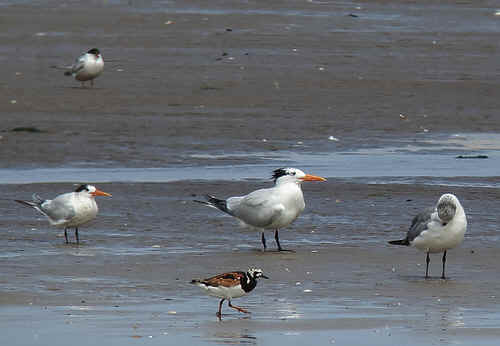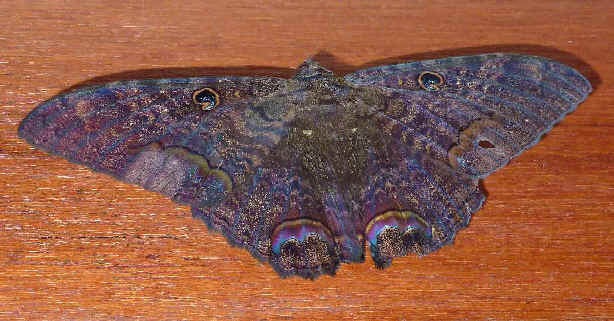The BIRDLINE and NATURELINE by ARMAS HILL
With an
Elegant Tern, a lost crow, and a Black Witch
Armas Hill has presented the "Birdline", originally from
Philadelphia, on the phone and internet for over 3 decades, and on the radio
in Delaware for about 10 years.
Links:
A
List & Photo Gallery of North American Birds, in 6 Parts
A
List & Photo Gallery of North American Mammals
A Chronological
List of Upcoming FONT Tours Other
Birdlines/Naturelines

These photos are of
species referred to in this September 8, 2012 edition of the Birdline/Natureline:

The first Elegant Tern
in New Jersey
(the left-most bird),
with comparatively a Royal Tern,
at Sandy Hook, New Jersey
in August 2012.
(photo by Peter Burke, the finder of the tern)

The moth known as the
Black Witch
The
Birdline & Natureline for September 8, 2012:
Along the Atlantic seacoast of New Jersey,
there have been some notable BIRD HAPPENINGS this past
week.
The first ELEGANT TERN for New Jersey was identified. It was
actually found last month. It has continued, as of today, at Sandy
Hook, on the New Jersey side to the entrance of the
harbor for New York City.
The second REDDISH EGRET for New Jersey was re-found on August 31
further north along the coast from where it had been seen the
previous week, when it was at Brigantine Refuge.
On August 31, in the evening, it was found by a couple
who were kayaking in the Island Beach State Park.
Also of interest there, that evening, were about 30 BROWN
PELICANS, and 2 pairs of COMMON EIDERS that have spent the summer
there, along a dike.
Today at the southern tip of the New Jersey, at Cape May, a
MAGNIFICENT FRIGATEBIRD was found in the morning perched on a
channel marker, in an area where last summer there was a BROWN
BOOBY.
The FRIGATEBIRD was seen in that area later in the day.
More about the ELEGANT TERN shortly, but first let's do some
follow-up to a big story here last week, the influx of RED
CROSSBILLS coming south in the northern United States.
The huge influx noted last time in Duluth, Minnesota,
with thousands of RED CROSSBILLS seems to have dissipated. On
August 31 at Hawk Ridge in Duluth, there were only 19. On
September 1, 24. The next 2 days none. On September 4, one. On
September 5, 15.
But in the East, there were some reports of RED CROSSBILLS, and
notable among them were a group of 7 in New York City,
in Central Park in Manhattan on August 31, spending much of that
day in evergreen trees in the area of the Shakespeare
Garden.
In Maine, over 25 RED CROSSBILLS were at Schoodic
Point on August 29. In New Hampshire, 30 RED
CROSSBILLS were at Carter Hill in Concord on September 2.
A state that doesn't get mentioned here often is Rhode
Island. In that smallest US state, there were 6 RED
CROSSBILLS on September 1 in West Glocester.
On the small island of Block Island, offshore in Rhode Island, on
August 31, there were 50 RED-BREASTED NUTHATCHES, several PURPLE
FINCHES, 25 BALTIMORE ORIOLES, and, from the West, a LARK
SPARROW.
CLAY-COLORED SPARROWS have been at a couple Rhode Island
locations: in Narraganset on August 31, and in Barrington on
September 1.
A RAVEN was at Long Pond in Hopkinton recently, a species not
usually thought of as being in Rhode Island.
East of Rhode Island, a LITTLE STINT has been in Massachusetts,
at Chatham on Cape Cod. Seen last weekend in fading breeding
plumage. Still there today.
Back to RED CROSSBILLS, they have been this week, on September 6, in
upstate New York at Long Lake in Hamilton County.
8 of them, sounding as they flew, like "type 3".
RED CROSSBILLS nested in that area during the summer of 2011, but
they were not found to do so there this
summer.
WHITE-WINGED CROSSBILLS were there throughout this summer.
Both CROSSBILLS were there last winter. Single RED CROSSBILLS
were noted in that region this summer in June and
July.
It seems as if the RED CROSSBILLS that have been irrupting
in the central & eastern US are "type 3", typically
found in the Pacific Northwest.
For such a large irruption, it is the earliest ever noted.
Normally such movements east have been in October & November.
A flying and calling RED CROSSBILL in northeastern Pennsylvania in
Lackawanna County on September 2 was said, by the listener, not to
sound like the RED CROSSBILLS he knew in the Great Smoky Mountains
of North Carolina & Tennessee.
RED CROSSBILLS have been observed this week moving southward along
ridge in Pennsylvania, at places such as Hawk Mountain and
Little Gap. 25 were seen at Little Gap on September 25.
In addition to RED CROSSBILLS going south at Hawk Mountain,
other birds there on August 31 & September 1 included:
PURPLE FINCHES, RED-BREASTED NUTHATCHES, and RUSTY
BLACKBIRDS.
Almost 150 (149) RUBY-THROATED HUMMINGBIRDS were counted
as they flew by Hawk Mountain on August 31.
The most common WARBLER there Aug 31-Sep 1 was the
TENNESSEE. Over 100 SCARLET TANAGERS were noted.
Records were broken on September 5 at hawk watches along
Pennsylvania ridges for the number of BALD EAGLES.
Along the Kittatinny Ridge, at Little Gap, in Northampton County,
that day, there were 47, a single-day record.
Further south, at Bake Oven Knob that day, there were 30 BALD
EAGLES. At Hawk Mountain that day, 36.
Further south yet, at Waggoner's Gap, that day, there were
24.
At the hawk watch at Stone Mountain, in Allensdale PA, on
September 5, there were 17, a one-day record for that site.
At the Waggoner's Gap hawk watch, in the non-hawk department, on
September 2, a YELLOW-HEADED BLACKBIRD perched on a snag for 5
minutes. It was among many GRACKLES that moved through for 2 to 3
days.
At Hawk Mountain, in the non-bird department, on September 4,
there was an amazing flight of migrating MONARCH BUTTERFLIES, with
883 counted, mostly in 2 hours.
Back in Duluth, Minnesota, in the
hawk-department, a MISSISSIPPI KITE was seen in West Duluth on
September 3. A few days earlier, on August 27, a MISSISSIPPI KITE
was seen at the Hawk Ridge hawk watch in Duluth.
Back at Cape May, New Jersey, on September 5,
there was a massive evening flight of migrating NIGHTHAWKS. They
were streaming along the tip of the peninsula, past the Cape May
Point State Park, by the dozens, then hundreds, about 750 to 1,000
feet above the ground. Between 200 and 300 were seen out offshore.
At the state park, between 6:10pm and 7:10pm, 1,202 COMMON
NIGHTHAWKS were tallied.
That exceeds by quite a bit the previous Cape May high count for
the species, of 200, on September 6, back in 1934.
During the late morning on September 5, 2012, over 4,000 BOBOLINKS were
counted at Cape May.
Now, back to a species mentioned as this edition of the Birdline
began, the ELEGANT TERN. It was said that the bird that's been
recently at Sandy Hook is the first for New Jersey.
A few notes follow here regarding the ELEGANT TERN. It's a species
with a story.
It breeds on the Pacific side of North America,
in a restricted range from southern California to central Baja
California, and in the area of the Gulf of California in Mexico.
90 per cent or more of the total known breeding
population has been said to nest in a single colony on
the island Isla Rosa in the Gulf of California.
It has also been said that in southern California the
species has expanded its breeding range northward, with some
breeding sites having increased in size during the last 30
years, from a few hundred pairs to thousands.
The ELEGANT TERN is primarily coastal, but inland
stragglers have been recorded at the Salton Sea in California, where it has become annual, and in
Arizona, where
there have been very few records.
It regularly wanders north to northern California as a
post-breeding visitor from mid-summer into autumn. With recent El
Nino events, these northern incursions seem to have increased.
Birds have reached as far north as British Columbia.
The ELEGANT TERN was first recorded in Oregon in 1983. But it
is now an annual occurrence there.
In Washington State, the ELEGANT TERN is said to be an
"irregular fall migrant along the coast, usually absent, but
common during El Nino years".
The main post-breeding dispersal is to the south of the breeding
area, with birds wintering along the Pacific coasts of America,
mainly in Peru and northern Chile.
But a few remain in the north as far as California, and others
reach as far south as central Chile, to the latitude of Santiago.
Coastal records on the Atlantic side of North America
are these:
1) Corpus Christi, Texas, July 25, 1889, a
specimen
2) Chincoteague, Virginia, June 20, 1985, an
adult photographed
3) Honeymoon Island, Florida, October 22
-November 1999, an adult
4) Fort DeSoto, Florida, late fall-early winter 2000-2001
(returning of 3)?)
5) Texas, November 2001
6) Tampa, Florida, May 23, 2002, an adult paired with a SANDWICH
TERN and found incubating
7) Chatham, Massachusetts, August 6-18, 2002,
determined after a debate to be an ELEGANT TERN and not the first
North American record of a LESSER CRESTED TERN
8) Dry Tortugas, Florida, April 8, 2004, another debated
individual, but rejected as deemed a possible SANDWICH x ELEGANT
HYBRID
9) Virginia Beach, Virginia, August 8, 2009, orange-billed.
Inland, the first (and I assume the only) ELEGANT TERN in Minnesota
was found on June 28, 2007 with some CASPIAN TERNS on Little
Pelican Island in Leech Lake, Cass County.
Most interesting is that the ELEGANT TERN has occurred in EUROPE!
A friend in the UK has kindly given me this summary, that I'll
paraphrase:
The accepted records there are of 2 or 3 or more returning birds
in France, some of which have been banded, and
some of which have been hybridizing with SANDWICH TERNS.
Some of these same birds, and most likely other individuals too
have also been seen in Ireland (2 or 3
records), Britain (2 or 3 records), and Spain
(quite a few records, where some returning individuals have been
banded, and some found to be hybridizing with SANDWICH TERNS as in
France).
A number of these birds have caused debate, and some have not
been "accepted".
There have been, at times, some "odd" terns that look
like LESSER CRESTED TERNS but with white rumps. They should be
gray, or more appropriately in Europe, "grey". They
could be LESSER CRESTED x SANDWICH HYBRIDS. Or ELEGANT x
SANDWICH HYBRIDS.
To see more about this:
http://www.birdingworld.co.uk/BirdingWorldIndex1.htm
An aside: A BLACK SKIMMER, from North America, was said to
have been seen last week in Europe, in Ireland.
But, only and unfortunately, as a "fly-by".
The ELEGANT TERN in New Jersey has been with
other TERNS, including similar ROYALS.
Regarding that ELEGANT TERN, these features have been noted:
- twice as tall as a standing COMMON TERN , but notably smaller
than a ROYAL TERN
- with an orange bill fading to paler yellow, thinner than that of
a ROYAL TERN
- with a shaggy black crest that goes forward surrounding the eyes
in a slight mask
- with white uppertail coverts contrasting slightly with a
pale gray back (in the US of course "gray")
Not that far from Sandy Hook, New Jersey, as the
"CROW" would fly, off Long Island, New York,
in the water known as the Long Island Sound last
weekend, the oscar-winning actor, Russell Crowe, got lost while
kayaking.
Having gone from Cold Spring Harbor in the afternoon, he
and a friend lost their way as it got dark. They made it back
to shore beaching their kayak about 10 miles from where they
had set out.
There, they were picked up by a U.S. Coast Guard boat and
ferried back to the harbor. That's my "lost crow"
story.
A very large MOTH called the BLACK WITCH was found in Oley,
in Berks County, Pennsylvania, the last week of
August. It was found resting on a tire.
The BLACK WITCH is a tropical moth that is a rare visitor to
Pennsylvania.
In Jamaica, where the BLACK WITCH is called the
"DUPPY BAT", it is believed to be the
embodiment of a lost soul or a soul not at rest.
In Jamaican English, the word "duppy" is associated with
malevolent spirits returning to inflict harm upon the living, and
"bat" refers to anything other than a bird that flies.
On Cat Island, in the Bahamas, where the BLACK
WITCH is known locally as the "MONEY MOTH", or the
"MONEY BAT", the legend is that if it lands on someone,
that person will come into money.
To see a photo of the BLACK WITCH, click the link below. Go in the
family NOCTUIDAE to number #405.
http://www.focusonnature.com/MothsOfEasternNorthAmerica.htm
That BLACK WITCH photo was sent to us by a gentleman from England
who took the picture onboard a cruise ship in the Caribbean.
In the list of eastern North American moths, in the link above,
there are now 1,040 species, some with photos that we appreciated
receiving. We plan, in time, to add more photos into the
list.
A couple months ago, in July, a number of people at various
places took part in what was called NATIONAL MOTH WEEK.
It was something new, started by some people to get more people
interested in looking at and learning about MOTHS.
So, people gathered, for example, in western Wisconsin,
where they set up light fixtures, and after dark they shone lights
on a white sheet that attracted MOTHS.
Here's a link to some of what was seen. Interesting.
http://www.aprairiehaven.com/?p=15047
Next month, a Focus On Nature Tour is scheduled to
be in Wisconsin, and nearby Minnesota.
To include Hawk Ridge in Duluth, referred to here earlier,
and also to include in Wisconsin: the Crex Meadows Wildlife
Area, the International Crane Foundation, a renowned "Birds
in Art" exhibition, and a visit to a wild area in the
northern part of the state, where we'll join with people from the
Timber Wolf Alliance in an area where those wild animals live.
For information about this tour, October 17 to 27,
and others:
www.focusonnature.com
The Birdline (and the Natureline)
are affiliates of Focus On Nature Tours.
Armas Hill has presented the Birdline, originally from
Philadelphia, on the phone and internet for over 3 decades, and on
the radio in Delaware for 10 years.
To
Top of Page



